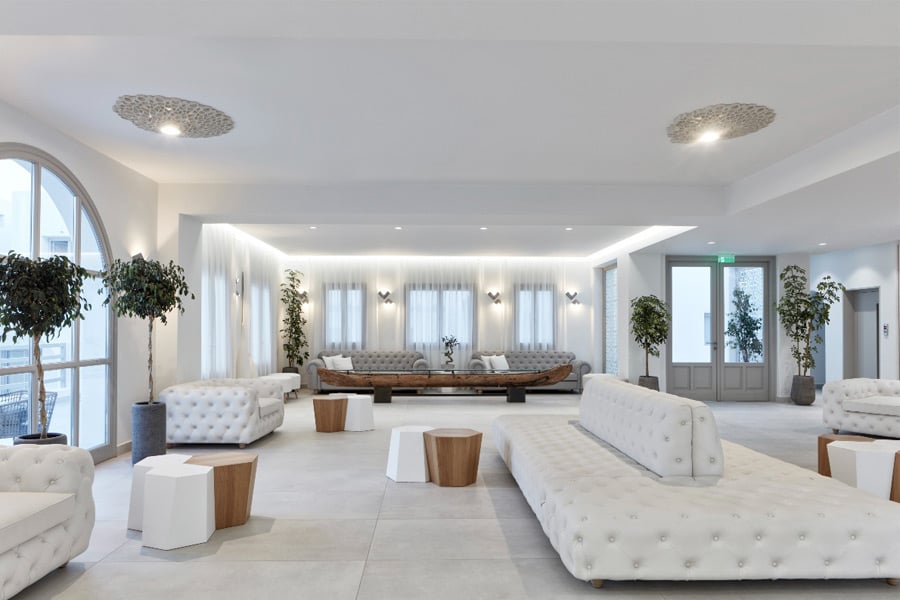When it comes to designing a contract environment, examining the lighting in the smallest detail and adapting it to different spaces is of fundamental importance, even if it is often considered by many owners simply as a finishing touch.
A carefully designed lighting design project will be able to shape the atmosphere, offer maximum comfort and create a unique and distinctive mood which, in addition to ensuring optimal brightness, will also be able to enhance the location’s overall image, emphasizing the style of the structure and furnishings.
Therefore, each specific area of the space requires suitable lighting fixtures based on functionality, the aesthetic goal, and the client’s personality.
The first fundamental step is to establish where and how you can arrange the wall or ceiling lights. This decision should be based on the effect you want and the arrangement of the furniture and other furnishing accessories such as statues or paintings.
In this article, we will look at:
- Wall or ceiling lights: differences
- 5 solutions to help you choose wall or ceiling lights according to the environment
- Wall or ceiling lights: a question of balance

Umarell
Wall or ceiling lights: differences
As already mentioned, as a hotel or restaurant owner, you most likely focus your attention on the stylistic choice of furnishings and accessories, completely neglecting the importance of lighting.
Sometimes the difference between wall or ceiling lights isn’t very clear.
Explaining the characteristics of each type is the first step you should take to give your client an idea of what you are talking about and guide them in the right choice. Let's clarify:
- When talking about wall lights, we are referring to appliques, luminous lighting fixtures that resemble ceiling lights but are attached to the wall and not the ceiling.
Wall lamps are suitable for both diffused lighting and as a complement to other lighting fixtures present.
Identifying the correct arrangement and the right height based on their function is fundamental. For example, they could be used for general or accent lighting to highlight specific elements. Doing this helps you avoid an unpleasant "blinding" effect and establish the arrangement of the furnishings.
Once the connections for the wall lights have been installed, they will occupy space, which will make it difficult to set up furniture or decorative elements.
- Ceiling lights (which are attached to the wall and do not take up space), pendant lamps (one or more hung from the ceiling via a cable,) and chandeliers (a more "important” type of lighting, which is usually the main one, with several lights attached called arms).
The latter two, in particular the chandeliers, are the protagonists of large environments both for their size and from the point of view of lighting, filling the spaces and enhancing the space below.
It is important to underline how, in your hotel lighting project, or restaurant, it is not necessarily a matter of choosing between wall or ceiling lights, but finding the best way to integrate them both to obtain a harmonious result in line with the structure’s mood and atmosphere and the type of clients.
Therefore, always keep in mind, when choosing decorative lighting for your hospitality project, the difference between the three fundamental levels of lighting:
- Ambient
- Task lighting
- Accent lighting
These must be well integrated to find the right balance between decorative and technical lighting.
5 solutions to help you choose wall or ceiling lights according to the environment
When it comes to illuminating an accommodation facility, identifying the different functional areas is essential. Based on the activities that will be carried out there, you should opt for wall or ceiling lights, positioning them strategically and always keeping in mind the importance of perfectly integrating artificial light with natural light.
So let's take a look at how to choose the lighting based on the environment.
1. How to illuminate a restaurant’s dining room
In addition to food, of course, a restaurant’s lighting is an element that invites customers to come back. It creates subtle balances of lighting to support the main visual task, that is, to enhance the colors and freshness of the dishes and promote conviviality.
Combining design and functionality by choosing the right lighting is even more important where natural light is lacking.
The temptation to create a welcoming and perhaps romantic atmosphere should not lead to the error of relying only on soft ambient lighting.
Place ceiling lights such as pendant lamps on each table, large, small, or multiple tables, to provide lighting in line with the room’s size and the overall style.
2. Ceiling lights for halls and receptions
The hall is the first space customers see when entering a hotel. So, it must welcome them with the right light to put them immediately at ease.
To achieve this, the ideal choice is to choose ceiling lights. Chandeliers, ceiling lights, or a composition of suspensions positioned above workstations can provide the necessary directional lighting while giving the customer an immediate feeling of comfort.
The reception, where the hotel staff welcomes guests, is a crucial moment that requires the presence of task lighting.
Depending on the size of the desk, you could opt for one or more suspension lamps positioned above the workstation to ensure a direct beam of light. The choice between a more dominant or a more intimate light will depend on the feeling the hotel wants to convey.

Notredame
3. Combining wall and ceiling lights in corridors
The role of the corridors is to allow good visibility so that customers can orient themselves and move easily between their rooms and the various areas of the hotel.
The lighting, in this case, must act as a "guide" as well as a decorative element for these transit areas.
The best choice is to arrange recessed or wall lamps or, in the case of large and particularly long corridors, a combination of central ceiling lights and wall lights to obtain uniform lighting.

Agua
4. Where you should put lights in the bedrooms
The bedrooms are the heart of the hotel and must ensure maximum comfort and relaxation.
When choosing the lighting, you need to focus on warm colors, while avoiding strong contrasts and looking for the right balance to create movement without being bothersome.Moreover, in this case, wall and ceiling lights can be integrated with the use of suspension lamps in the center of the room to create ambient lighting.
And appliques can provide diffused light above the bedside tables, guaranteeing practical light where needed most, for example, while reading.

Cobu
5. Which lamps you should put in the bathrooms
If the windows are small or completely absent, the main lighting should be as close to natural as possible.
To ensure diffused light, use ceiling lights in the center of the room, such as classic ceiling lights if the ceilings are low or chandeliers if the size and style of the room allow it.
Two lights on the wall on the sides of the mirror, on the other hand, will allow the face to be illuminated without shadows. And some spotlights on a bathtub or inside the shower will instead create delicate and relaxing light accents.
Wall or ceiling lights: a question of balance
We have seen the main differences between wall or ceiling lights and how deciding between the two is a consideration to be made upstream based on the effect you want to obtain and taking into account the arrangement of furniture, furnishing accessories, and the type of rooms in hotels and restaurants.
However, from our analysis, we have found that choosing one solution doesn’t exclude the other. Instead, finding the right balance between the different types of lighting to guarantee that every room has the right level of ambient, task, and accent lighting capable of highlighting the characteristics of each room and making it perfectly functional with respect to its intended use.



